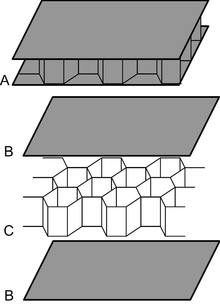 A sandwich-structured composite is a special class of composite materials that is fabricated by attaching two thin but stiff skins to a lightweight but thick core. The core material is normally low strength material, but its higher thickness provides the sandwich composite with high bending stiffness with overall low density. Open- and closed-cell-structured foams like polyvinylchloride, polyurethane, polyethylene or polystyrene foams, balsa wood, syntactic foams, and honeycombs are commonly used core materials. Open- and closed-cell metal foam can also be used as core materials. Laminates of glass or carbon fiber-reinforced thermoplastics or mainly thermoset polymers (unsaturated polyesters, epoxies...) are widely used as skin materials. Sheet metal is also used as skin material in some cases. The core is bonded to the skins with an adhesive or with metal components by brazing together
A sandwich-structured composite is a special class of composite materials that is fabricated by attaching two thin but stiff skins to a lightweight but thick core. The core material is normally low strength material, but its higher thickness provides the sandwich composite with high bending stiffness with overall low density. Open- and closed-cell-structured foams like polyvinylchloride, polyurethane, polyethylene or polystyrene foams, balsa wood, syntactic foams, and honeycombs are commonly used core materials. Open- and closed-cell metal foam can also be used as core materials. Laminates of glass or carbon fiber-reinforced thermoplastics or mainly thermoset polymers (unsaturated polyesters, epoxies...) are widely used as skin materials. Sheet metal is also used as skin material in some cases. The core is bonded to the skins with an adhesive or with metal components by brazing togetherTypes of sandwich structures
Metal composite material (MCM) is a type of sandwich formed from two thin skins of metal bonded to a plastic core in a continuous process under controlled pressure, heat, and tension. Recycled paper is also now being used over a closed-cell recycled kraft honeycomb core, creating a lightweight, strong, and fully repulpable composite board. This material is being used for applications including point-of-purchase displays, bulkheads, recyclable office furniture, exhibition stands, and wall dividers. To fix different panels, among other solutions, a transition zone is normally used, which is a gradual reduction of the core height, until the two fiber skins are in touch. In this place, the fixation can be made by means of bolts, rivets, or adhesive.
Properties of sandwich structures
The strength of the composite material is dependent largely on two factors:
The outer skins: If the sandwich is supported on both sides, and then stressed by means of a force in the middle of the beam, then the bending moment will introduce shear forces in the material. The shear forces result in the bottom skin in tension and the top skin in compression. The core material spaces these two skins apart. The thicker the core material the stronger the composite. This principle works in much the same way as an I-beam does. The interface between the core and the skin: Because the shear stresses in the composite material change rapidly between the core and the skin, the adhesive layer also sees some degree of shear force. If the adhesive bond between the two layers is too weak, the most probable result will be delamination.
Application of sandwich structures
Sandwich structures can be widely used in sandwich panels, this kinds of panels can be in different types such as FRP sandwich panel, aluminum composite panel etc. FRP polyester reinforced composite honeycomb panel (sandwich panel) is made of polyester reinforced plastic, multi-axial high-strength glass fiber and PP honeycomb panel in special antiskid tread pattern mold through the process of constant temperature vacuum adsorption & agglutination and solidification.
References , copy from http://en.wikipedia.org/wiki/Sandwich-structured_composite





0 Comments
Thank you !